Dies ist eine alte Version des Dokuments!
Citrus bergamia Risso & Poit. - syn.Citrus x limon ; Citrus aurantium var. bergamia Loisel. - Rutaceae - bergamot orange, Bergamotte
Citrus medica (x) Citrus × aurantium = Citrus x limon „… considered by some as the hybrid C. medica × (C. maxima × C. reticulata)“ http://www.ars-grin.gov/cgi-bin/npgs/html/taxon.pl?10698
„The bergamot orange is unrelated to the herbs known as bergamot or wild bergamot, Monarda didyma and Monarda fistulosa, which are in the mint family, and are named for their similar aroma… Bergamot peel is used in perfumery for its ability to combine with an array of scents to form a bouquet of aromas which complement each other. Approximately one third of all men's and about half of women’s perfumes contain bergamot essential oil. Bergamot is a major component of the original Eau de Cologne composed by Farina at the beginning of 18th century Germany… The distinctive aroma of bergamot is most commonly known for its use in Earl Grey tea.“ http://en.wikipedia.org/wiki/Bergamot_orange
„Since its mention 1750 as the bergamot was planted by a certain Nicolo Parisi, the oil of bergamot is an essential raw material for the perfume industry and especially gives 'Kölnisch Wasser' its typical odor.“ http://de.wikipedia.org/wiki/Bergamotte
The volatile residue of bergamot essential oil is a natural odour fixative, but problems with coumarins and photosensitizing properties of psoralens (bergapten) are reported. The percentage of bergamottin in the essential oil of C.bergamia of Calabrian origin ranges between 1-2.75%, 5-geranyloxy-7-methoxycoumarin 0.08-0.22%, citropten 0.14-0.35%, and bergapten 0.11-0.32%.
[On the genuineness of citrus essential oils. Part XL. The composition of the coumarins and psoralens of calabrian bergamot essential oil (Citrus bergamia Risso)., Mondello, L., Stagno d'Alcontres, I., Del Duce, R., Crispo, F., Flavour and fragrance journal, Vol.8(1), 1993, 17-24]
Enantiomeric distribution of chiral aroma compounds in authentic bergamot oil was 63-71%ee S(-)-α-pinene, 90-91%ee S(-)-β-pinene, and 95-98%ee R(+)-limonene. α-Terpineol values ranged from 23-64%ee S(-). Cold pressed bergamot oil without juice contact may contain 100%ee R(-)-linalool. On standing (72h) at pH 2 (cold citric acid 5%), R(-)-linalool racemizes (53% R, 47% S). Bergamot oil from various sources contained R(-)-linalool from 64-100% ee.; authentic cold pressed oils with 100% R(-)-linalool are possible. „Under hydrodistillation conditions, most of the oil is removed from the vicinity of the acid in the first few minutes, so prolonged distillation under these conditions will not increase the amount of racemisation found…“
[The effect of processing on chiral aroma compounds in fruits and essential oils., Baigrie, B.D., Chisholm, M.G., Mottram, D.S., Special Publications of the Royal Society of Chemistry, 197, 1996, 151-157]
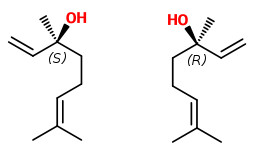 linalool stereo isomers: (S)-(+)-linalool (coriandrol: sweet, floral) and (R)-(-)-linalool (licareol: floral, woody lavender) | 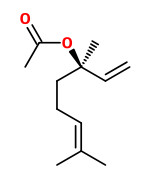 (R)-(-)-linalyl acetate |  (Z)-limonene oxide | 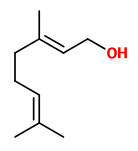 geraniol |  ɣ-terpinene |
„The volatile components of bergamot (Citrus bergamia Risso) essential oil produced in Reggio Calabria in Italy were investigated … Fifty-five compounds in the oil were identified by GC and GC-MS. The major compounds were limonene (37.2%), linalyl acetate (30.1%), linalool (8.8%), γ-terpinene (6.8%) and β-pinene (6.2%). In sensory analysis, odour description and flavour dilution (FD) factors of each component were evaluated by GC-sniffing and aroma extraction dilution analysis (AEDA). Bergamot-like odour components were (Z)-limonene oxide, decanal, linalyl acetate and geraniol. A mixture of eight other components, such as limonene, linalool, γ-terpinene and others, in addition to the four bergamot-like aroma compounds, brought about an aroma model of bergamot odour with the similarity of 7.1 by the nine-point-score sensory test.“
[Characteristic odour components of bergamot (Citrus bergamia Risso) essential oil. Masayoshi Sawamura1, Yuji Onishi, Junko Ikemoto, Nguyen Thi Minh Tu and Nguyen Thi Lan Phi, Flavour and Fragrance Journal (2006), Vol. 21, Issue 4, 609-615]
In bergamot peels and essential oils (home-made and commercial), the (R)-(+)-enantiomer of limonene dominated (98-100%), whereas linalool and linalyl acetate occure as optically pure (R)-(-)-enantiomers. Limonene occurred as an optically pure (R)-(+)-enantiomer in bergamot flesh, while linalool and linalyl acetate were not detected.
„Linalool and linalyl acetate were racemic or almost racemic [(R)-(-), 49-64%] in all commercial flavoured teas, while the enantiomeric ratio of (R)- and (S)-limonene was found to be similar to the ratio of limonene enantiomers in bergamot peels and oils. Since it was clearly shown that natural bergamot flavour contains only one pure enantiomer or very high enantiomeric purities of the (R)-(-)-linalool and (R)-(-)-linalyl acetate, the racemates and the other enantiomeric mixtures of those compounds in the commercial flavoured teas and concentrate imply adulteration of the products. The enantiomeric distribution of linalyl acetate and linalool was not changed during officinal steam distillation. No changes in the relative proportions of the enantiomers of linalyl acetate were reported, but linalool tended to racemize during acidic distillation of bergamot essential oil.“
[Ravid, Uzi, et al. „Authenticity assessment of natural fruit flavour compounds in foods and beverages by auto‐HS-SPME stereoselective GC-MS.“ Flavour and fragrance journal 25.1 (2010): 20-27]
„Bergamot oil is the only citrus oil in which (+)-limonene (26%) is not the dominant component. The oil is instead rich in linalool (16%) and linalyl acetate (34%). In addition, further 175 constituents have bee characterized, of which 26 (96% of the total oil) occur in concentrations above 0.1%. As with other citrus oils, the majority of the components are present in trace amounts… trans-bergamotene (0.3%) being the dominant sesquiterpene… important trace constituents are aldehydes of the β-substituted α-methyl acrolein type such as β-sinensal, lanceal, and bergamotenal [with its strong woody odor], despite their low abundance… the important ketones are (+)-nootkatone, (+)-8,9-didehydronootkatone, and camphorenone.“
[Scent and Chemistry, Günther Ohloff, Wilhelm Pickenhagen, Philip Kraft, Wiley-VCH, 2012, 232-233]
„Bergamot (Citrus bergamia, Risso) is a fruit most knowledgeable for its essential oil (BEO) used in aromatherapy to minimize symptoms of stress-induced anxiety and mild mood disorders and cancer pain though the rational basis for such applications awaits to be discovered. The behavioural and EEG spectrum power effects of BEO correlate well with its exocytotic and carrier-mediated release of discrete amino acids endowed with neurotransmitter function in the mammalian hippocampus supporting the deduction that BEO is able to interfere with normal and pathological synaptic plasticity. The observed neuroprotection in the course of experimental brain ischemia and pain does support this view.“
[Neuropharmacology of the essential oil of bergamot., Bagetta, G., Morrone, L.A., Rombolà, L., Amantea, D., Russo, R., Berliocchi, L., Corasaniti, M.T. Fitoterapia, Vol.81(6), 2010, 453-461]
The 3-hydroxy-3-methylglutaryl neohesperidosides of hesperetin (brutieridin) and naringenin (melitidin), isolated from the fruits of bergamot, were identified to be structural analogues of statins, lipids concentration lowering drugs that inhibit 3-hydroxy-3-methylglutaryl-CoA reductase (HMGR).
[Statin-like principles of bergamot fruit (Citrus bergamia): isolation of 3-hydroxymethylglutaryl flavonoid glycosides., Di Donna, L., De Luca, G., Mazzotti, F., Napoli, A., Salerno, R., Taverna, D., Sindona, G., Journal of natural products, Vol.72(7), 2009, 1352-1354]
[On the inhibitor effects of bergamot juice flavonoids binding to the 3-hydroxy-3-methylglutaryl-CoA reductase (HMGR) enzyme., Leopoldini, M., Malaj, N., Toscano, M., Sindona, G., Russo, N., Journal of agricultural and food chemistry, Vol.58(19), 2010, 10768-10773]
„Bergamot albedo, the white tissues between the skin and the pulp, is a polluting waste in the production of the renowned fragrance and is easily available by simple industrial processes. Brutieridin and melitidin are found in bergamot albedo and possess statin-like activity. Their anticholesterolaemic effect has been proved in vitro. Different procedures were exploited to assay the presence of brutieridin and melitidin and to evaluate their availability in water extracts. The best results in terms of simplicity and accessibility of the method were obtained with hot water at 65 °C. Interestingly, tea beverages enriched with the two active principles have been obtained by simple addition of dried albedo into commercial tea bags.“
[Recycling of industrial essential oil waste: Brutieridin and Melitidin, two anticholesterolaemic active principles from bergamot albedo., Di Donna, L., Gallucci, G., Malaj, N., Romano, E., Tagarelli, A., Sindona, G., Food chemistry, Vol.125(2), 2011, 438-441]
„The estimated concentration of 5 main flavonoids [in bergamot peel extract,BPF] was: neoeriocitrin (77,700 ppm), naringin (63,011 ppm), neohesperidin (72,056 ppm), melitidin (15,606 ppm) and brutieridin (33,202 ppm)… BPF, given orally for 30 days to both rats and patients, reduces total and LDL cholesterol levels (an effect accompanied by elevation of cHDL), triglyceride levels and by a significant decrease in blood glucose. Moreover, BPF inhibited HMG-CoA reductase activity and enhanced reactive vasodilation thus representing an efficient phytotherapeutic approach in combating hyperlipemic and hyperglycaemic disorders“
[Hypolipemic and hypoglycaemic activity of bergamot polyphenols: from animal models to human studies., Mollace, V., Sacco, I., Janda, E., Malara, C., Ventrice, D., Colica, C., Romeo, F., Fitoterapia, Vol.82(3), 2011, 309-316] http://www.ihfglobal.com/education_documents/Bergamia%20Risso%20Study.pdf
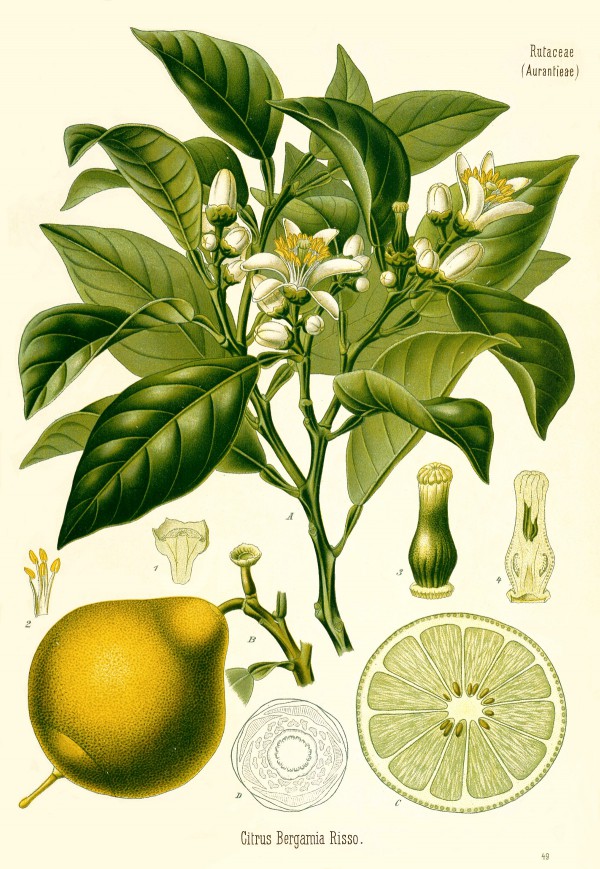
Köhler,F.E., Medizinal Pflanzen, vol.3, t.49 (1890)
http://plantgenera.org/species.php?id_species=249920
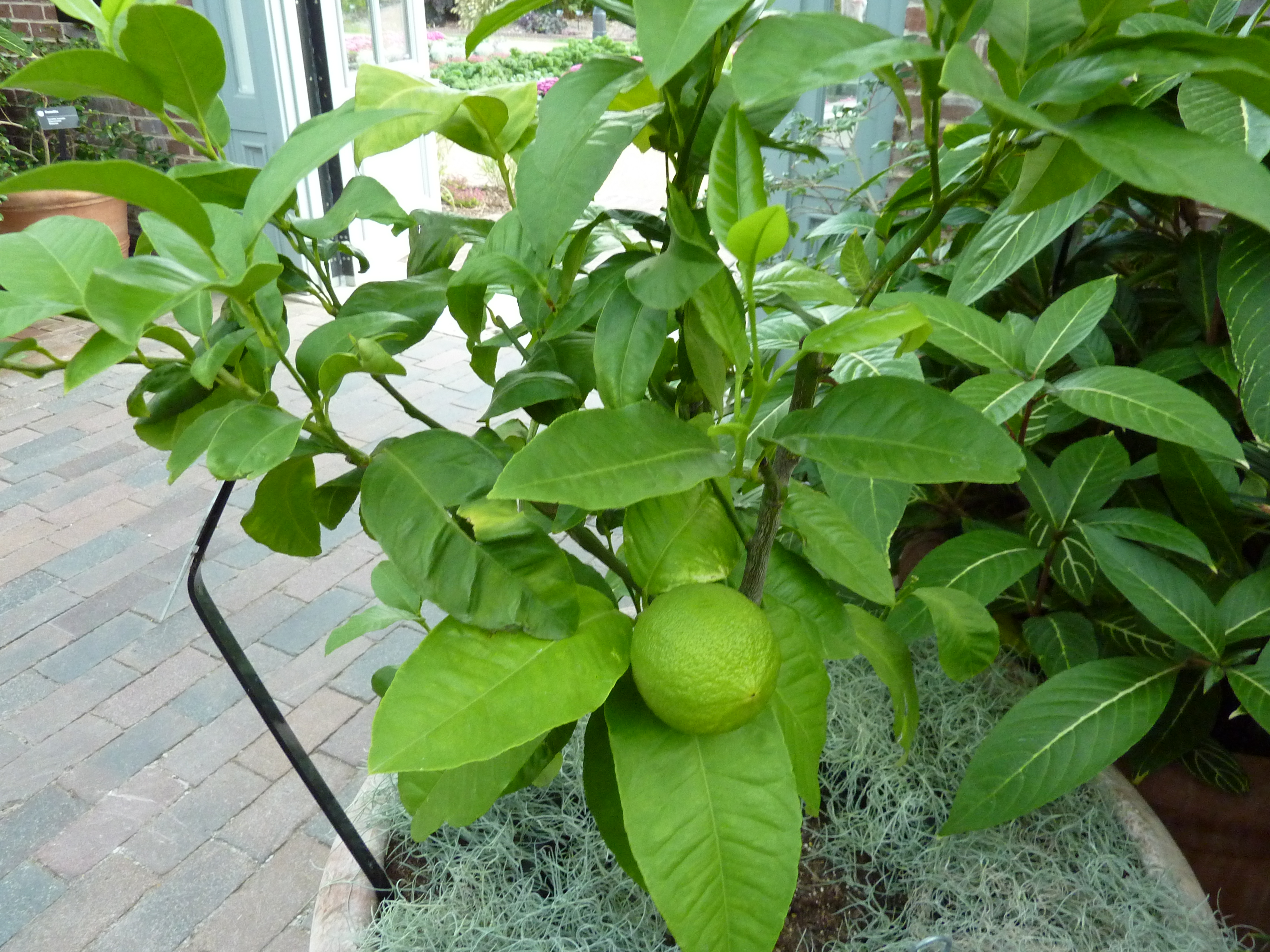
Bergamot, Citrus bergamia, in the Linnean House of the Missouri Botanical Garden (2011)
CC BY-SA 3.0, Author James Steakley Wikimedia Commons
